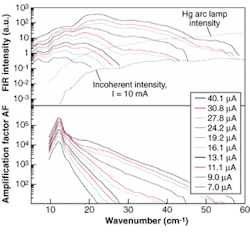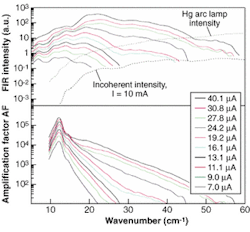Ring produces stable broadband terahertz radiation
Terahertz radiation fills the gap between the microwave boundary of about 300 GHz and the infrared boundary of about 20 THz. Despite its considerable practical potential, the terahertz region has not been used very much for spectroscopy. Possible applications range from spectroscopy of trace gases in space to biological and medical tasks, nondestructive testing, drug discovery, and public security.
Appropriate light sources have been developed—for example, by extending the spectral range of lasers to longer wavelengths. Another approach is to use electromagnetic devices such as free-electron lasers, synchrotrons, and electron storage rings for terahertz radiation generation. The latter strategy was used last year by Jefferson Laboratory (Newport News, VA) to achieve a landmark—subpicosecond electron bunches in a linear accelerator were magnetically bent, yielding coherent broadband high-brightness terahertz radiation.1 To achieve coherence, the physical length of a bunch of accelerated electrons was made shorter than the wavelength of the emitted radiation. In that case, the radiation power increases proportionally to the square of the number of electrons within a bunch, due to coherent superposition of the field amplitudes. This technique, together with the high repetition rate of the accelerator, provided 20 W of terahertz radiation, about five orders of magnitude higher than any electromagnetically driven terahertz source thus far.
Now, highly stable coherent broadband terahertz emission has been obtained from the 1.7-GeV BESSY II electron-storage ring (Berlin, Germany).2 The average power amounted only to 1 mW at the experimental port, but the beam excelled in its high stability—convenient for spectroscopy (when linear accelerators are used for the generation of terahertz radiation, stability is a problem).
The BESSY II ring offers 400 electromagnetic "buckets" to store electrons in well-separated bunches (with about 109 electrons per bunch) orbiting at almost the speed of light. At the bending magnets, synchrotron radiation is emitted due to the radial acceleration, spanning a spectrum from 0.1 nm to the millimeter range. Emission occurs tangentially and can be coupled out at appropriate ports. Because the round-trip travel of a bunch takes 800 ns, the upper limit of the repetition rate of the pulsed radiation amounts to 500 MHz when all buckets are filled.
Low-alpha mode shortens pulses
The BESSY researchers made special efforts to provide short bunches to achieve coherence. They operated the storage ring in the so-called low-alpha mode. Alpha characterizes the change of the electron-orbit length per electron-momentum change; at the same time it influences the oscillation amplitudes of the bunch electrons within their potential buckets. As the result of low-alpha operation, the bunch length could be reduced to 1 mm, corresponding to a 3-ps pulse duration. In this way, the proper condition was fulfilled for each bunch so that coherence was obtained for the terahertz wing of the spectrum. Coherence was tested by measuring the radiation intensity in the terahertz wing vs. beam current by increasing the number of electrons in a bunch. It approached square dependence with increasing current.3
Low-alpha-mode terahertz spectrum emitted by the storage ring was measured by a Fourier spectrometer for various electron currents (see Fig. 1). Somewhat surprisingly, the coherent spectrum reaches to shorter wavelengths (higher energies) than expected from a bunch length of 1 mm with pure Gaussian shape. It is likely that the bunches become deformed to non-Gaussian shapes. Further investigation is under way.
At the BESSY II synchrotron, coherent light with spectral peaks in the terahertz range was obtained at different beam currents per electron bunch from 7 up to 40 µA, with 100 electromagnetic "buckets" consecutively filled (top). In comparison, the spectral intensity for totally incoherent emission at an average current of 10 mA, as well as the intensity of incoherent emission from a mercury-arc lamp, shows a different shape. Coherent emission boosts the storage-ring spectral intensity over a region from about 40 cm-1 (1.2 THz) to 10 cm-1 (the cutoff wavelength of the vacuum vessel). The ratio of the different curves to their individual incoherent spectrum produces curves that, for all currents, peak at about 12 cm-1 with amplification of greater than 105 for the higher currents (bottom). Over a range of greater than 30 cm-1, the coherent contribution to the spectrum exceeds the incoherent contribution by two to five orders of magnitude.
To examine the spectral brilliance, the emission was compared to that of an 80-W mercury-arc lamp representing a blackbody at 4500 K. At 20 cm-1, the storage ring produced an approximately 500-times-higher flux onto a 2-mm-diameter detector than did the arc lamp. Typical signal-to-noise ratios of 400 could be achieved in the terahertz and subterahertz range for spectroscopic applications. Two orders of magnitude more power could be generated in a burst mode with more current per bunch, probably not suitable for spectroscopic applications.
The BESSY II experiments have opened the door to broadband terahertz spectroscopy. The storage ring will be operated from time to time in that mode to explore and optimize the coherent radiation conditions and to offer experimenters the possibility to perform measurements in the terahertz range. It should be noted that tabletop tunable and closed-cycle-cooled lasers now also emit in that region, offering a complementary approach to terahertz spectroscopy. For example, inter-valence-band germanium lasers have reached several watts output, allowing narrowband operation and tunability across a wide spectral range.4 Thus, both broadband and narrowband terahertz spectroscopy are now possible.
REFERENCES
- G. L. Carr et al., Nature 420, 153 (2002).
- M. Abo-Bakr et al., Phys. Rev. Lett. 90(9) 094801 (2003).
- M. Abo-Bakr et al., Phys. Rev. Lett. 88(25) 254801 (2002).
- E. Bründermann et al., Appl. Phys. Lett. 76 2991 (2000)

